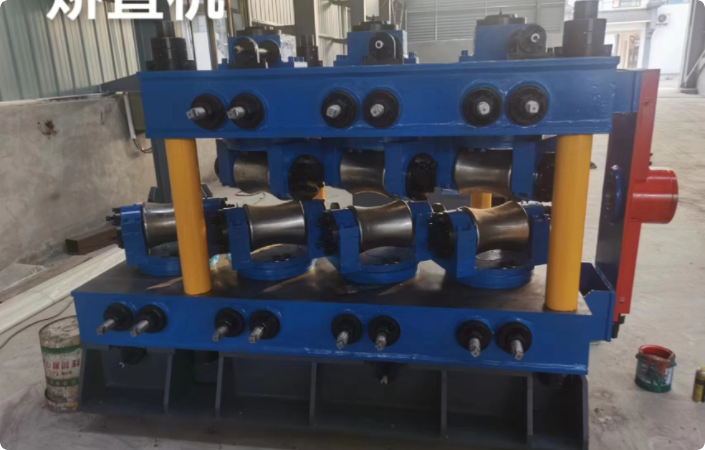straightener and roller machine
Understanding Straightener and Roller Machines Essential Tools for Metal Fabrication
In the world of metal fabrication, the importance of precision and efficiency cannot be overstated. As industries strive to achieve higher quality products at faster rates, the need for advanced machinery becomes ever more crucial. Among the various tools used in metalworking, straightener and roller machines play a pivotal role. These machines significantly enhance the quality of metal components by ensuring that they are properly aligned and shaped, which is essential for various applications in sectors ranging from automotive to aerospace.
The Functionality of Straightener Machines
Straightener machines are designed to remove internal stresses from the metal sheets or bars and to straighten them to the desired specifications. When metals are produced, especially during the processes of rolling and bending, they often develop defects such as twists, bends, or warps. These imperfections can impact the quality of the finished product and cause challenges during further fabrication processes such as welding or assembly.
A straightener machine typically operates by feeding the metal through a series of rollers that exert pressure on it. The combination of these rollers can be adjusted to accommodate different thicknesses and types of metals. The machine’s alignment and pressure settings are crucial, ensuring that the material maintains its integrity while being straightened. High-precision straighteners can also incorporate CNC (Computer Numerical Control) systems, allowing for enhanced accuracy and repeatability in operations.
The Role of Roller Machines
On the other hand, roller machines serve a different but complementary function in the metalworking process. These machines are often used for bending and shaping metal sheets. By passing the metal through a series of rollers, operators can create curves, angles, and other shapes required for specific applications.
Roller machines can be categorized into several types, including initial rollers for gentle forming, bending rollers for creating arcs, and folding machines for making sharper angles. Similar to straighteners, they come in varying configurations, including two-roll, three-roll, and four-roll systems, each serving different purposes based on the type of bending required.
Technical Specifications and Features
straightener and roller machine

Modern straightener and roller machines are equipped with a range of features that enhance their functionality and efficiency. These can include
1. Hydraulic Controls Many machines now utilize hydraulic systems that allow for precise adjustments to pressure and alignment, making it easier to handle various types of materials. 2. Digital Displays and Controls Advanced machines incorporate digital interfaces that provide real-time data on the machine’s status, allowing operators to monitor its performance and make adjustments with ease.
3. Safety Mechanisms Given the significant forces involved in metal processing, modern machines are equipped with safety features such as emergency stop buttons, shields, and automatic shut-off systems to protect operators.
Applications in Industries
Straightener and roller machines find their applications in numerous industries. In the automotive sector, for example, they are used to create the precise framing components and body panels necessary for vehicle assembly. In aerospace, the need for high-strength, lightweight components makes the use of these machines essential to ensure that metal parts meet stringent safety and performance standards.
Moreover, they are widely used in construction, manufacturing, and various engineering applications, highlighting their versatility and importance. Businesses leveraging these machines can significantly enhance their production quality, reduce waste, and increase operational efficiency.
Conclusion
In conclusion, straightener and roller machines are indispensable tools in the metal fabrication industry. Their ability to correct defects and shape materials with precision has made them integral to manufacturing processes across multiple sectors. As technology continues to advance, the future of these machines looks bright, with innovations that promise even greater efficiency and capabilities. Companies that invest in modern straightening and rolling technologies are likely to gain a competitive edge in an increasingly demanding marketplace, making these machines not just useful, but essential for success in metalworking.
By understanding and utilizing straightener and roller machines effectively, fabricators can ensure that they deliver high-quality, precise metal products that meet the exact specifications required by their industries.
-
High Frequency Straight Seam Welded Pipe Production Line-BzZhou Xinghua Machinery Equipment Manufacturing Co., LTD.|Precision Steel Pipe Manufacturing&Industrial EfficiencyNewsJul.29,2025
-
High-Frequency Straight Seam Welded Pipe Production Line-BzZhou Xinghua Machinery Equipment Manufacturing Co., LTD.|Precision Steel Pipe Manufacturing&Industrial EfficiencyNewsJul.29,2025
-
High Frequency Straight Seam Welded Pipe Production Line-BzZhou Xinghua Machinery Equipment Manufacturing Co.,LTD.NewsJul.29,2025
-
High Frequency Straight Seam Welded Pipe Production Line-BzZhou Xinghua Machinery Equipment Manufacturing Co., LTD.|Precision Engineering&CustomizationNewsJul.29,2025
-
High-Frequency Straight Seam Welded Pipe Production Line-BzZhou Xinghua Machinery Equipment Manufacturing Co.,LTD.|Line Pipe Steel&Welded Gas PipeNewsJul.29,2025
-
High Frequency Straight Seam Welded Pipe Production Line - BzZhou Xinghua|Steel Pipe Manufacturing, High-Frequency WeldingNewsJul.29,2025


